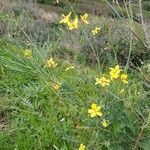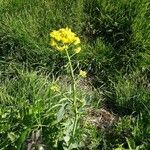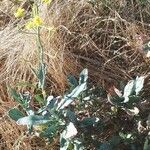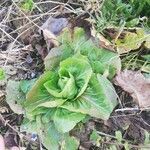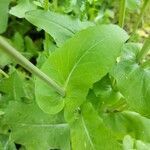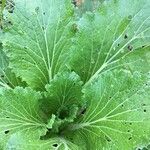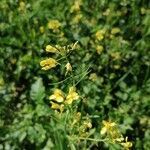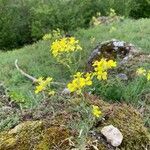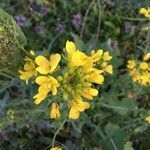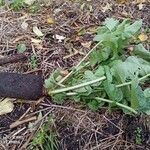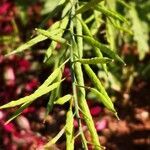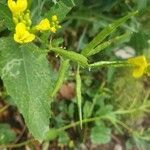Annuals or biennials; (roots fleshy or slender); (green to slightly glaucous), glabrous or sparsely hairy. Stems unbranched or branched distally, 3-10 dm. Basal leaves: petiole (winged), (1-)2-10(-17) cm; blade ± lyrate-pinnatifid to pinnate to pinnatisect, (5-)10-40(-60) cm × 30-100(-200) mm, (margins sinuate-dentate, sometimes ciliate), lobes 2-4(-6) each side, (terminal lobe oblong-obovate, obtuse, large, blade surfaces usually setose). Cauline leaves (middle and distal) sessile; base auriculate to amplexicaul, (margins subentire). Racemes not paniculately branched, (with open flowers overtopping or equal to buds). Fruiting pedicels ascending to spreading, (5-)10-25(-30) mm. Flowers: sepals (3-)4-6.5(-8) × 1.5-2 mm; petals deep yellow to yellow, obovate, 6-11(-13) × (2.5-)3-6(-7) mm, claw 3-7 mm, apex rounded; filaments 4-6(-7) mm; anthers 1.5-2 mm. Fruits ascending to somewhat spreading, torulose, terete, (2-)3-8(-11) cm × 2-4(-5) mm; valvular segment with 8-15 seeds per locule, (1.3-)2-5(-7.5) cm, terminal segment seedless, 8-22 mm. Seeds black, brown, or reddish, 1.1-2 mm diam.; seed coat very finely reticulate-lightly alveolate, not mucilaginous when wetted. 2n = 20.
Annual or biennial herb with thin or stout, often fusiform to tuberous taproot.. Stem erect, branched, glabrous or slightly hispid below (rarely higher up), up to 150 cm. high.. Basal leaves ± indistinctly petioled, bright green, hispidulous, lyrate-pinnatipartite, dentate, crenate or sinuate; terminal lobe large, orbicular to ovate, obtuse, cordate; lateral lobes in up to 5 pairs, rather small, ovate to triangular; lower cauline leaves sessile, clasping, pinnatifid; upper cauline leaves ± glaucous, sessile, distinctly clasping, undivided (fiddle-shaped, narrowly triangular or lanceolate), entire to repand-dentate.. Racemes loosely corymbiform with open flowers overtopping the buds; in fruit very elongate; pedicels 10–30 mm. long.. Sepals yellow-green, spreading, 5–8 mm. long.. Petals yellow, clawed, with obovate slightly emarginate blade, 6–11 mm. long.. Anthers ± 2 mm. long.. Ovary with 20–30 ovules.. Siliquae linear, rarely on a gynophore, 40–100 mm. long, 2.5–4 mm. broad; beak 5–30 mm. long with 0–1 seed.. Seeds dark brown, globose, 1.0–1.5 mm. in diameter, with a fine distinct reticulum.
Annual to 8 dm, green and sparsely setose-hispid, at least along the lf-margins and the midrib beneath; lower lvs petioled, pinnately ± lobed; upper lvs oblong to lanceolate, dentate or entire, sessile and clasping; fls 1 cm wide; mature pedicels widely ascending, 1–2 cm; frs ascending to suberect, terete or nearly so, 3–5 cm, the slender beak 8–15 mm; seeds 1.5–2 mm, minutely roughened; 2n=20.B. rapa as here defined includes the field-weed (often called B. campestris L.) and a number of cultivars derived from it, notably turnip and bird’s rape. The related sp. B. oleracea L., glabrous and glaucous, 2n=18, includes a host of cultivars (cabbage, cauliflower, broccoli, Brussels sprouts, etc.) derived from a wild European form that is often segregated as B. sylvestris (L.) Mill. Rape and rutabaga are referred to B. napus L. (2n=38), thought to be an alloploid of the other two spp. Infraspecific nomenclature here is tangled.
Annual with lax rosette. Stems erect or ascending, glabrous, to 1.5 m tall, sometimes becoming subwoody below. Lower lvs petiolate, lyrate-pinnatifid with large terminal and 1-3 pairs of lateral lobes, bright green, bristly, 15-25-(30) × 5-10 cm; margins sinuate, toothed. Upper lvs becoming amplexicaul, glaucous, not lobed, sessile, glabrous, narrowly triangular, entire, 2-10 × 1-2 cm. Racemes to 40 cm long; open fls overtopping buds. Sepals narrow-oblong, (4)-5-7 × 1-1.5 mm. Petals bright yellow, 6-10 × 3-4 mm. Lateral stamens spreading. Silique terete, glabrous, linear-lanceolate, slightly constricted between seeds, (30)-40-60 × 2-5 mm; gynophore 0; valves with prominent median and weaker lateral veins; beak tapering, seedless, 6-10 mm long. Seeds reddish brown, 1-1.5 mm diam.
Annual or biennial herbs with slender or stout, tuberous taproots. Basal leaves lyrate-pinnatisect, ±5-jugate, petiolate, shortly hispid or setose, green; lobes dentate, the terminal lobe broadly ovate, lobulate. Upper stem leaves simple, obovate-oblong, ± cordate at the base, sessile, amplexicaul, glaucous, repand-dentate to entire, glabrous or nearly so. Racemes dense in flower, the open flowers generally overtopping the buds; lax in fruit. Flowers yellow, the petals 6-10 mm long. Fruiting pedicels spreading. Siliquae 3.5-6.5 cm long, 2-4 mm broad, linear; valves bulged by the seeds, 1-nerved, reticulately veined; beak 0.8-2 cm long, attenuate. Seeds 18-24, 1.2-1.7 mm in diameter, generally dark-coloured with a reticulate seed-coat.
Annual or biennial herb; taproot stout or tuberous; stems erect, to 1 m tall, branched, hispid. Basal leaves petiolate, pinnatifid, hispid; upper leaves sessile, oblong-lanceolate, glabrescent, amplexicaul, the base deeply cordate. Inflorescence elongating from concave corymb. Sepals spreading, 4–6 mm long. Petals 6–11 mm long, bright yellow. Outer stamens with filaments curved outwards at base, shorter than inner stamens. Ovary sessile. Siliqua 4–6.5 cm long, 3 mm wide, obliquely erect; somewhat constricted between seeds; valves somewhat flattened; midrib prominent, lateral veins obscure, parallel; beak narrower than stigma, ¼–½ valve length, seedless. Seeds 1.5–2 mm wide, red to black-brown.
Annual or biennial herb, 0.3-1.5 m high, slender or stout, with tuberous taproots. Leaves: basal leaves lyrate-pinnatisect, ± 5-jugate, petiolate, hispid or setose, green margins dentate, terminal lobe broadly ovate, lobulate; upper cauline leaves simple, sessile, glabrous or nearly glabrous, obovate-oblong, margins repand-dentate to entire. Inflorescence a raceme, dense in flower, lax in fruit. Flowers yellow. Fruit a linear siliqua, valves bulged by seeds, 1-nerved. Seeds dark-coloured with a reticulate seed coat.
Annual or biennial herb, up to 1.5 m high. Stems erect. Leaves basal ones petiolate, blade lyrate-pinnatisect, lobes dentate, terminal lobe broadly ovate, lobulate, sparsely hispid; upper leaves sessile, simple, blade obovate-oblong, base amplexicaul, glabrous. Flowers: in dense racemes; petals 6-10 mm long, yellow; Nov.-Feb. Fruit with pedicels spreading; siliquae 35-65 x 2-4 mm, reticulately veined, beak 8-20 mm long, attenuate.
A cabbage family herb. It is an erect annual plant. It has a round white fleshed taproot. It is often tinged purple. The leaves are divided and have hairs. Where the leaves join the root it is not raised into a "neck". There are Asian or more tropical varieties. These will produce seed in warmer places. The wild form is a thin plant with leaves that clasp the stem. The pods are 4-6.5 cm long and have seedless beaks 2-3.2 cm long.
Annual or biennial herb. Upper stem leaves cordate at base, amplexicaul. Petals 6-10 mm long. Flowers yellow.
Basal leaves stalked, bristly, lyrate-pinnatifid, upper ones sessile, amplexicaul, ± glaucous.
Silique curved, erect, slightly flattened with a long, tapering beak.
Annual or biennial herb with stout or tuberous tap-root.
Seeds 1–5–2 mm. in diam., blackish or reddish-brown.
Flowers bright yellow, in terminal racemes.
Petals 4, 6–10 mm. long.
Sepals spreading.
Stamens 6.
